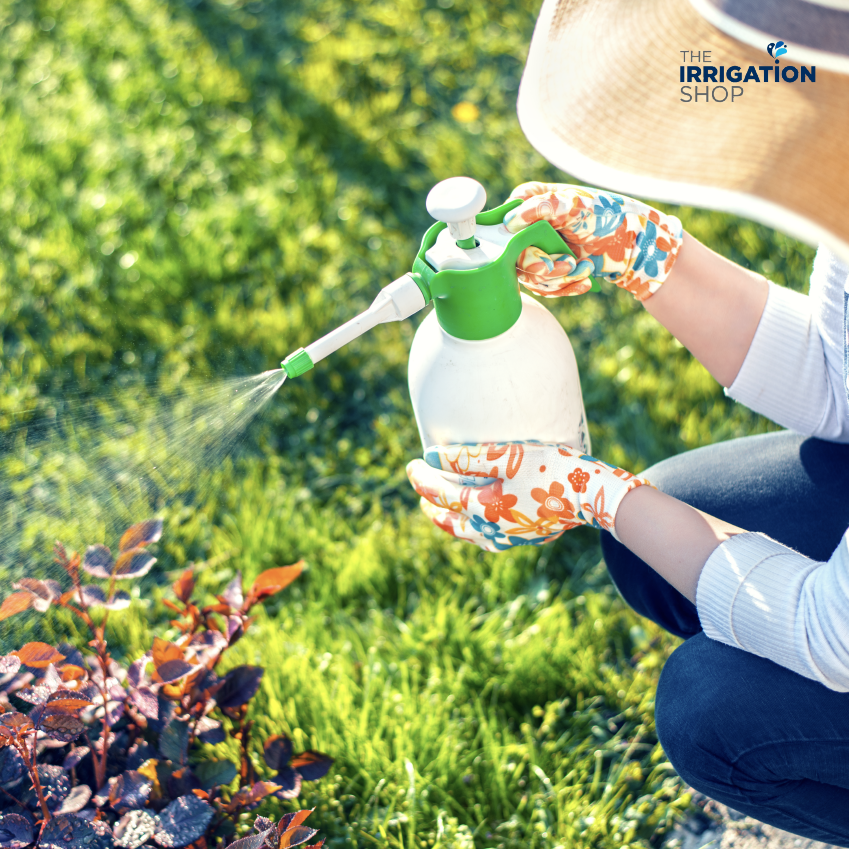A Guide to Choosing the Right Garden Sprayer
Keeping your plants watered regularly will help ensure that they’re green and healthy for years to come. While all plants need water, much like people, some are definitely a lot thirstier than others. If you have an irrigation system for your garden (or if you are considering installing one), you should ensure that it is optimised to suit the different types of plants. Here at the Irrigation Shop, we’ve created this handy guide to help you with optimising your irrigation system for this purpose.
Types of Garden Sprayers

There are various types of garden sprayers available on the market for gardeners:

Hand Sprayers
Hand sprayers are compact, lightweight, and perfect for small garden plots or indoor plants. They are simple to use — just fill the reservoir, pump the handle to build pressure, and spray. If your gardening routine involves precision spraying on a few plants or spot-treatment of pests and weeds, hand sprayers are your go-to option.

Backpack Sprayers
Backpack sprayers, as the name suggests, can be comfortably strapped onto the user's back. They are designed for larger gardens and can hold a larger volume of liquid, usually a few gallons. This sprayer type allows more time for spraying and less for refilling, optimizing your garden maintenance routine.

12 Volt Battery Sprayers
For those who wish to completely eliminate manual pumping, 12-volt battery sprayers are a dream come true. They maintain consistent pressure, ensuring that the spray's strength doesn't diminish over time, which is often a problem with manual sprayers. If you have an extensive area to cover or if you spray regularly, a 12-volt battery sprayer would be a worthy investment.

Chemical Pumps
Chemical pumps, or chemical sprayers, are designed to spray out more corrosive substances like pesticides, herbicides, or fertilizers. They usually come with durable seals and gaskets to resist chemical damage. If your garden requires regular application of such substances, investing in a chemical pump is advisable.
How to Use Garden Sprayers Effectively
Garden sprayers are fairly simple devices to use over all but it is useful to know how they work in case you need to troubleshoot them.

How Does a Garden Sprayer Work?
Hand Sprayers
Hand sprayers work by manual pressurization. When you pump the handle, air builds inside the tank, pressurizing the liquid. When the trigger is pressed, this pressure forces the liquid up a tube and out through the nozzle.
Backpack Sprayers
Backpack sprayers also rely on manual pressurization. A hand pump builds up air pressure inside the tank. When the lever is pressed, the pressure propels the liquid out through a wand and nozzle that can be directed as needed.
12-Volt Battery Sprayers
A 12-volt battery sprayer works on the same principle of pressure, but it uses a battery-powered pump to build that pressure, eliminating the need for manual effort. The pump keeps a consistent pressure to ensure a steady spray until the tank is empty or the power is turned off.
Chemical Pumpss
Chemical pumps, like the 12-volt battery sprayers, use a motorized pump to create pressure. They are designed to withstand corrosive substances by featuring more durable seals and gaskets. When activated, the pump forces the chemical solution up and out through a hose and nozzle.
Tips for Using Garden Sprayers
Always Read and Follow the Manufacturer's Instructions
Every sprayer is unique, and the manufacturer's manual will provide you with specific guidance for its use and maintenance. Not following the manual can lead to improper use or damage to the sprayer.
Adjust the nozzle for the desired spray pattern
Most sprayers allow you to adjust the nozzle to achieve different spray patterns, from a narrow stream to a wider mist. A narrow stream is great for targeted application, like attacking a specific weed, while a broader mist is better for applying a pesticide or fertilizer over a larger area.

Maintain a Steady Pressure for an Even Spray
If your sprayer requires manual pumping to build pressure, try to maintain steady pressure for an even spray. Inconsistent pressure can lead to inconsistent application of whatever you’re spraying. For sprayers with a pressure gauge, keep your pressure within the recommended range.
Rinse and Clean the Sprayer After Each Use
After each use, empty your sprayer, then rinse it with clean water. If you've been using chemicals, you might want to rinse it a couple of times to make sure all residues have been removed. Also, occasionally check the condition of the seals and gaskets, replacing them as needed.
Frequently Asked Questions (FAQ)
Q: How much pressure does a garden sprayer need?
A: The required pressure for a garden sprayer largely depends on the task at hand. Usually, a pressure of 20 to 40 PSI (Pounds per Square Inch) is sufficient for most garden sprayers.
Q: How to clean a garden sprayer nozzle?
A: After each use, rinse the sprayer and the nozzle with clean water. If the nozzle appears to be clogged, you can often disassemble it and clean the components with a soft brush or cloth.
Q: How do you maintain a sprayer after use?
A: After using, empty the sprayer, rinse it thoroughly with water, and clean the nozzle. Make sure to dry all parts before storing to avoid mold and bacteria growth. Inspect the sprayer regularly for any damage or wear and replace parts as needed.

Get a Full Range of Garden Sprayers From the Irrigation Shop
Choosing the right type of sprayers will save you time and keep your garden green and healthy. You can buy a full range of garden sprayers from us right here.
If you need further advice on which type of sprayer to use, make sure to contact us or visit us in store.



